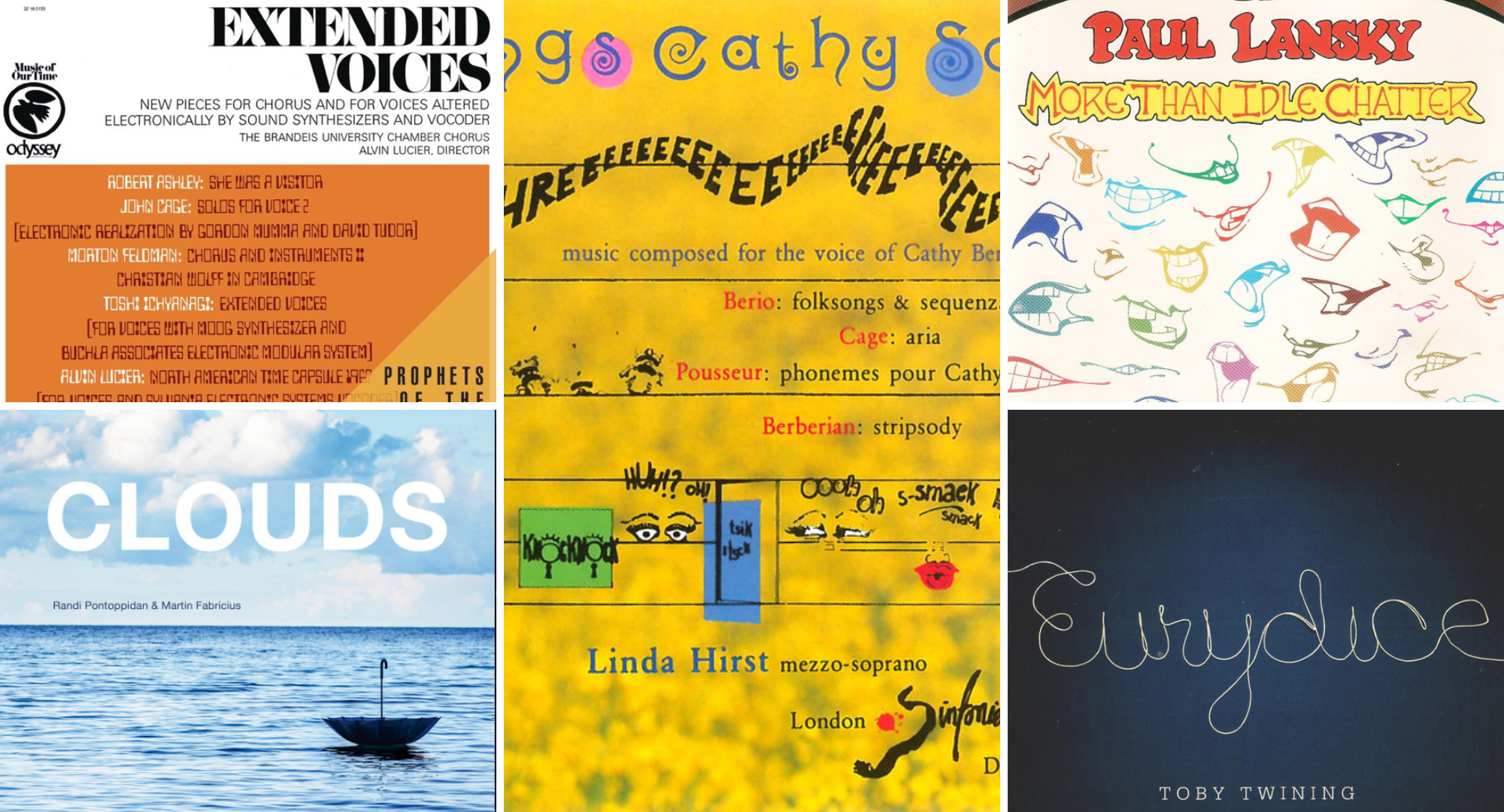This is another playlist built around a Listening List from 100 Days of Summer Listening. If you have been following on Instagram or YouTube, you’ll know it’s almost over! I hope you enjoy these works that feature extended vocal techniques (although for some of the performers, like Tonya Tagaq, they are utilizing techniques that are well established in their own cultural traditions), unique manipulation of the voice, and experimental electronic treatment of singing and speech. Many of these works are new to me, but many are also very nostalgic. I first heard Berio’s Sequenza III for voice almost 20 years ago, along with Cathy Berbarian’s Stripsody, and Toby Twining’s album Eurydice was in a grab bag I received at the 2011 Bang on a Can Summer Festival. I hope you enjoy these as much as I do. Happy listening.
To make sure these playlists delivered to your inbox every week, sign up for my newsletter.
I give this playlist a Difficult Listening Hour rating of 7/10.
Not really a disclaimer: While I curate my playlists to listen to in order, the list below has tracks from the same album grouped, really only to save me a little bit of time and sanity.
Yes! Yes! Yes! and The String Room from Toby Twining‘s album Eurydice.
This work is for four singers and cello, featuring male soprano (countertenor) Eric Brenner. This work originally started as a score for the play of the same name, written by Sarah Ruh.
Can Barely Feel My Feet by Lesley Flannigan. Album: Hedera.
From the composer’s bio, “Lesley Flanigan is an experimental electronic musician living in New York City. Inspired by the physicality of sound, she builds her own instruments using minimal electronics, microphones and speakers.”
Madwoman’s Vision from Meredith Monk‘s Book of Days.
From the composer’s bio, “Meredith Monk […] is a composer, singer, director/choreographer and creator of new opera, music-theater works, films and installations. Recognized as one of the most unique and influential artists of our time, she is a pioneer in what is now called “extended vocal technique” and “interdisciplinary performance.” Monk creates works that thrive at the intersection of music and movement, image and object, light and sound, discovering and weaving together new modes of perception.”
Aura (Laraaji Rework) by Hatis Noit and Laraaji. Album: Aura Reworks
From Hatis Noit’s bio, “…Japanese vocal performer hailing from distant Shiretoko in Hokkaido who now resides in London. Hatis Noit’s accomplished range is astonishingly self-taught, inspired by everything she could find from Gagaku — Japanese classical music — and operatic styles, Bulgarian and Gregorian chanting, to avant-garde and pop vocalists.”
As lightning comes, in flashes by Joan La Barbara. Album: The Early Immersive Music of Joan La Barbara (mode298)
From the liner notes, ” ‘as lightning comes, in flashes’ (1981) was originally done as a large-scale outdoor performance work, using multiple singers and dancers and large costumes which unfurled and were left behind as tangible remnants of the ephemeral sonic work. La Barbara subsequently created an 8-channel vocal composition that created a distinctive sonic environment by using variations of her own voice”
Erie Changys by Tanya Tagaq. Single: Erie Changys
From the composer’s bio, “From Ikaluktutiak (Cambridge Bay, Nunavut), internationally celebrated artist Tanya Tagaq is an improvisational singer, avant-garde composer and bestselling author.”
Sweet Land, Scene 1: Introduction with music by Raven Chacon and Du Yun and
libretto by Aja Couchois Duncan and Douglas Kearney. Album: Sweet Land
From the liner notes, “The opera Sweet Land, which premiered in February 2020, was a surreal travelogue through the Los Angeles State Historic Park. Separating the audience into two experiences of erasure and survival, Sweet Land explored the myths surrounding America’s origins by inventing a new, elemental myth of Hosts and Arrivals. As the natural landscape and the undeniable remnants of industrialization stood in silence, the land itself was a central character, stark relief to the fantastical world of an imaginary place called “Sweet Land.”
Every Day Medicine and Something by Eirik Hegdal performed by the Trondheim Voices. Album: The Sound of Contemporary Living
From the Trondeim website, “What is the sound of contemporary living? What is the soundtrack that follows our modern lives, our habits and everyday rituals? (which sometimes can seem quite absurd taken out of context..) This was the starting point of what was supposed to become the staged performance “The Sound Of Contemporary Living”, a collaboration between Trondheim Voices, choreographer Jo Strømgren and composer Eirik Hegdal. The show was hit hard by the pandemic, and then again by a strike in the Norwegian theatre industry.”
Reset by Martin Fabricius and Randi Pontoppidan. Album: Clouds.
From the liner notes, “Revered vocalist Randi Pontoppidan and leading vibraphonist Martin Fabricius proudly present the culmination of a blossoming musical relationship of the past eight years. Blending acoustic and electronic timbres, free improvisation and ethereal composition, their otherworldly universe ‘Clouds’ is set to release on the 12th of April. The duo first met in 2016, at Jazz Denmark’s Summer Session – a jazz camp for professionals, led by some of the world’s most renowned musicians, including Jamaladeen Tacuma – Ornette Coleman’s Prime Time bassist.”
Tulugak by Tonya Tagaq. Album: Animism
Circlesong One by Bobby McFerrin. Album: Circlesongs
I recommend reading the article on McFerrin’s website about this album.
Sequenza III by Luciano Berio performed by Linda Hirst. Album: Songs Cathy Sang
From the liner notes, “Cathy Berberian, a great mezzo-soprano with an incredibly varied vocal palette and a highly eclectic repertoire…, was above all the vocal muse of the entire musical avant-garde of the 1960s. She is particularly associated with the compositions of Luciano Berio, who was at one time her husband and composed the iconic and striking Sequenza III, a tour de force making use of all the expressive possibilities and all types of vocal emission of the performer, who must be as much an actress as a singer. … Other composers, such as John Cage and Henri Pousseur, have also dedicated her highly innovative compositions, involving a degree of randomness and leaving the singer a great deal of freedom. … Singer Linda Hirst, who knew her well as a former member of the Swingle Singers, paid tribute to Cathy Berberian in 1987 with this album of some of the most notable compositions dedicated to her.
Sound Patterns by Pauline Oliveros. Album: Extended Voices
A note from Discogs, “New pieces for chorus and for voices altered electronically by sound synthesizers and vocoder.” Released in 1967.
Stripsody by Cathy Berberian. Album: MagnifiCathy (The Many Voices Of Cathy Berberian)
From the composer’s bio (she was primarily a performer), “Cathy gained notoriety as a virtuosic interpreter of new music and was esteemed for the extraordinary wit and intelligence with which she approached any project. She possessed an astonishing “rapid-reflex” technique by which she shifted seamlessly between disparate music styles, invoking Marlene Dietrich, baby talk, bird call, and Sprechstimme in one musical line, and her impeccable vocal technique also lent insight to stylized trilling and ululation.”
New Start by Jaap Blonk. Album: New Start
From the composer’s bio, “Jaap Blonk (born 1953 in Woerden, Holland) is a self-taught composer, performer and poet. … As a vocalist, Jaap Blonk is unique for his powerful stage presence and almost childlike freedom in improvisation, combined with a keen grasp of structure. He has performed around the world, on all continents. With the use of live electronics and interactive visuals the scope and range of his concerts has acquired a considerable extension.”
Vesper Sparrow by Missy Mazzoli performed by Room Full of Teeth. Album: Render
Program notes, “Vesper Sparrow was commissioned and premiered by Grammy award-winning vocal octet Roomful of Teeth in 2012. The work was inspired by Sardinian “cantu e tenore” vocal techniques, and includes an imitation of the call of the vesper sparrow. Farnoosh Fathi’s poem “Home State” weaves in and out of the texture. The work was recorded for Roomful of Teeth’s Grammy-nominated album Render.”
Aria with Fontana Mix by John Cage, performed by Nicholas Isherwood, tape Realised by G. Verlingieri. Album: Aria: Nicholas Isherwood Performs John Cage
From the John Cage Trust website, “The score for this virtuosic work consists of 20 pages of graphically-notated music, each equating to 30 seconds in performance. That said, pages may be performed over longer or shorter time spans to create a program of a determined time-length. Aria may be performed as a solo, or with Fontana Mix and/or with any of the parts comprising Concert for Piano and Orchestra. The text consists of isolated vowels and consonants, as well as words, from Armenian, Russian, Italian, French, and English. The notation is colorful and graphic, consisting, essentially, of wavy lines in different colors and 16 black squares denoting “non musical” vocal noises. The colors denote different singing styles, which are determined by the singer prior to performance. Cage used Fontana Mix as his composing means to create Aria, a work with which it is frequently performed.”
Loudspeakers (for Morton Feldman): Voice Leading by Charles Amirkhanian. Album: Charles Amirkhanian: Loudspeakers
About the composer, from the liner notes, “Charles Amirkhanian (b 1945) can be regarded as a central figure in American music, and on several fronts. As a composer, he’s been pervasively innovative in two genres: text-sound pieces, in which he can draw engaging rhythmic processes from wacky word assemblages such as “rainbow chug bandit” and “church car rubber baby buggy bumper”; and natural-sound electronic pieces which go far beyond the usual confines of musique concrète to create long, poetic sound narratives poised between collage and sonic landscape.”
Idle Chatter by Paul Lansky. Album: More Than Idle Chatter.
I encourage you to read the composer’s article about this album on his website.
Mourning by Gelsey Bell. Album: Mɔɹnɪŋ (Morning / /Mourning)
From the liner notes, “mɔɹnɪŋ [morning//mourning] is the studio album of Gelsey Bell’s experimental chamber opera, featuring the original cast. Leaping off from the thought experiment (inspired by Alan Weisman’s The World Without Us) of what would happened to the Earth if all humans disappeared right now, the piece explores a literally post-human possible future.”
Water/Sky Rant by Meredith Monk. Album: On Behalf of Nature
From the ECM website, “On Behalf of Nature is a meditation on our intimate connection to nature, its inner structures, the fragility of its ecology and our interdependence.” Voices and instruments have equal weight: sometimes each is heard alone; sometimes they are blended to form a new, mysterious sound; sometimes they are combined to create intricate, layered, yet transparent sonic landscapes.”
Hee-oo-hm-ha by Toby Twining. Album: Shaman.
From a Gramophone review, “All the music presented on this CD makes use of extended vocal techniques, many of which are derived from ethnic cultures such as Mongolian overtone singing, vocal fry from Tibet, rhythmic panting from African and Inuit music and pygmy yodelling. However. these techniques are blended further with elements that derive from pop, rock and jazz, contemporary music (Berio, Ligeti and American minimalists spring to mind) and even early chanson music.”

